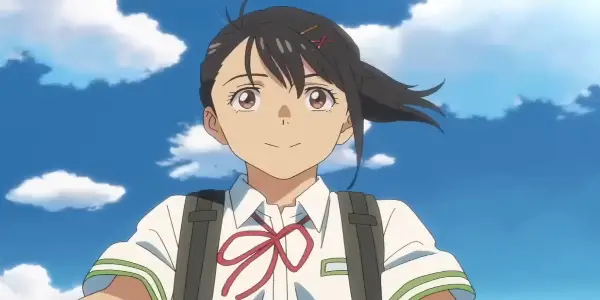It’s enlightening listening to director Makoto Shinkai‘s comments pertaining to his latest film Suzume no Tojimari (Literally, “Suzume’s Locking Up”). Although it fits squarely into his oeuvre following another plucky heroine coming of age in a Japan wracked by geological devastation, it had some very meaningful inspiration.
In March 11, 2011, the largest earthquake in Japan’s recorded history devastated the Tohoku region. Although Shinkai lived and worked in Tokyo at the time, well outside the epicenter, he felt mixed emotions of both relief and guilt. Seeing as his greatest gift was making animated films, he vowed to do just that for all those who had been affected. It’s easy to see how these events might have influenced Your Name and Weathering with You, but it’s even more intimately connected to Suzume.
The story follows an orphaned high schooler named Suzume who lives on the island of Kyushu. One morning, on the way to school, she passes a dark and mysterious young man who asks for directions to the nearest ruins. In that moment, her youthful heart decides to follow him and thus starts the wheels turning on a grand adventure.
Shinkai once more employs supernatural metaphors to comment on the ecological state of our world. In a repeated prayer inflected with Shinto belief, they call out to nature, “Oh divine gods who dwell beneath this land you have long protected us for generations.”

Souta Munataka comes from a long line of “Closers,” people entrusted with closing portals all across Japan prohibiting the supernatural worms from entering the earth and precipitating earthquakes. It’s not quite blessed with the mythology and world-making of Lord of The Rings, but it is something.
Souta becomes her Strider — a mysterious figure leading her through this world — as they look to recover a cat-shaped keystone and close doors across the nation so the disasters don’t spread. The added wrinkle is that Souta gets transformed, not into a pumpkin, but a 3-legged chair with deep personal significance to Suzume.
The movie almost runs off the tongue like a nursery rhythm about a young girl and the man who turned into a chair, that chased after a cat who got away on a boat. It beggars belief but also serves as a handy MacGuffin to move the plot forward as they follow the cloyingly cute Daijin all across Japan.
In one blink-and-you’ll-miss-it easter egg, there’s a social media post with a snapshot of a cat on a train with the caption “OMG I feel like I’m in Whisper of The Heart.” Anyone familiar with Ghibli’s classic entry from Yoshifumi Kondo and Hayao Miyazaki, will no doubt appreciate the reference.
On The Road
Suzume evolves into a Japanese road movie and the convention works because Shinkai always seems to take such great care with the specificity of his locales. Settings are made recognizable through their geography and identifiable landmarks, and that’s something he’s maintained from earlier efforts. These places are animated but still fundamentally real.
He also creates helpers to aid Suzume on her way including the plucky Chika who offers her fellow teenager food and shelter when she needs it most. Then, a kindly woman gives our heroine a lift to Kobe; she’s a mother of two by day and a hostess at night. Finally, Suzume’s Tokyo-bound heading to Ochanomizu and crossing paths with Souta’s raffish classmate who smokes cigarettes and drives a convertible though he’s training to be a high school teacher.
I’m no urban historian, and I’ve only visited Ochanomizu out of all these locations. However, it did make me curious about the deeper significance of each stop on the trip. Tokyo, of course, was at the center of the Great Kanto earthquake of 1923. Before 2011, it was one of the seismic events in modern Japanese history. You don’t need to know this, but it lends a deeper significance to Suzume’s journey as she confronts her past. We know all roads must lead back to Tohoku where she grew up…
Like the writer-director’s prior two efforts, Suzume boasts the soaring arrangements of Radwimps again with the addition of newcomer Toaka‘s haunting vocals on the title track. There’s also the placement of some classic tracks during the film’s digression on the road. It brings out the nostalgic vibes and plays like anime’s answer to a Guardians of The Galaxy romp. My personal favorite needle drop is Yumi Arai‘s peppy “Rouge No Dengon” no doubt familiar to fans of Kiki’s Delivery Service.
It’s these moments that feel the least driven of the film and somehow become a kind of saving grace as a respite before we go hurtling toward a patented Shinkai conclusion. Because soon enough as life takes on these seismic implications, it makes the quotidian rhythms feel twee and insignificant in comparison.
Conclusion: Suzume
If you’re familiar with any of Makoto Shinkai‘s filmography, he’s going to give you human drama on a gargantuan scale through a confluence of all the tools at his disposal. He certainly knows how to utilize the medium, and it’s the kind of memorial to the Tohoku earthquake only he would be capable of making.
Sometimes the greatest service is providing your audience with quality entertainment. Shinkai‘s not completely escapist, but he also does not shy away from being a fantastical romantic. That’s probably why he’s found such an ardent audience in Japan and the world over. Here he vows to face the trauma head-on and comes out on the other side offering an inkling of hope.
Watch Suzume
Does content like this matter to you?
Become a Member and support film journalism. Unlock access to all of Film Inquiry`s great articles. Join a community of like-minded readers who are passionate about cinema - get access to our private members Network, give back to independent filmmakers, and more.